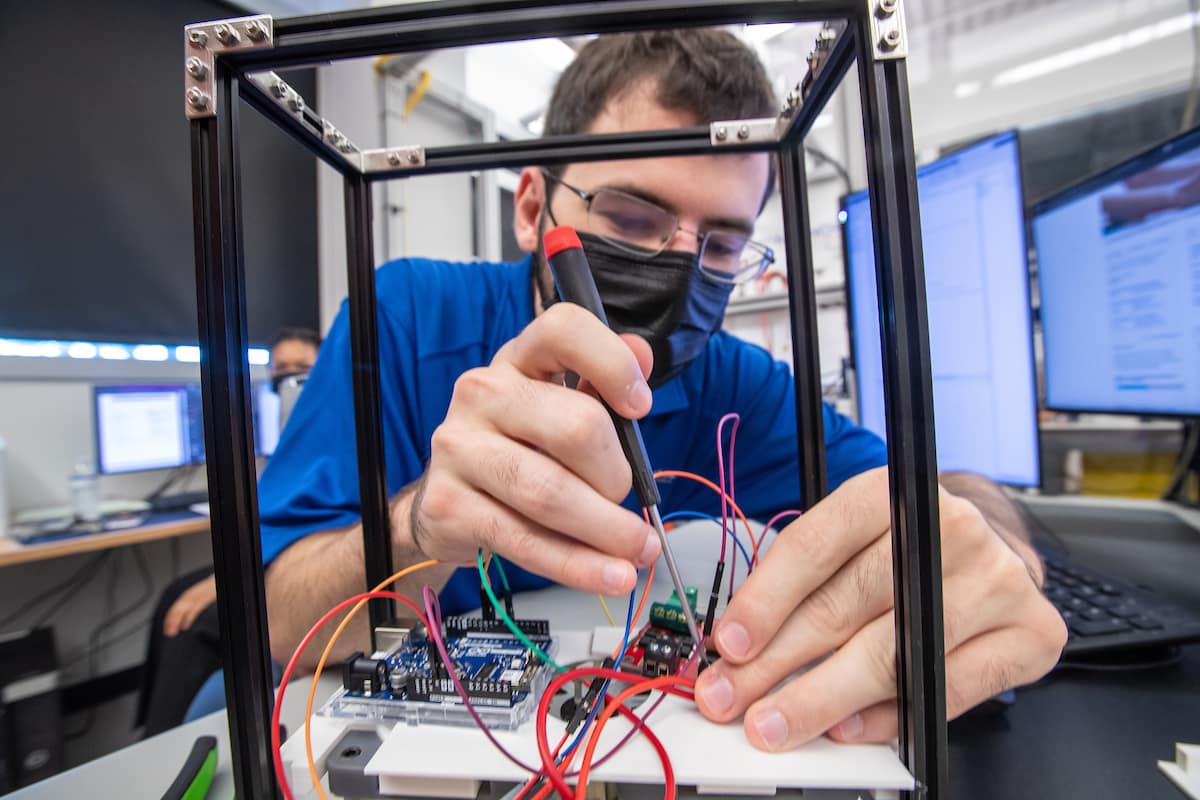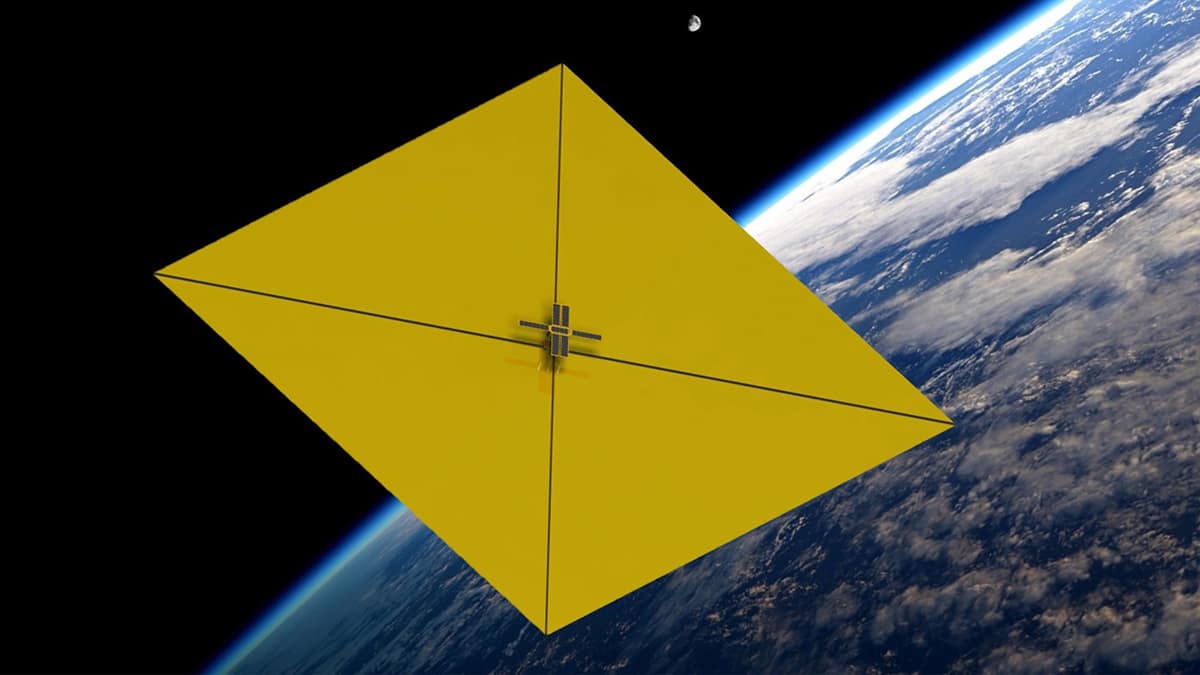Solar-Propelled Invention Designed to Clean Up Space Trash

A sail that unfurls itself to propel a cube satellite using the sun’s power — developed by Embry-Riddle Aeronautical University researchers — suggests a sustainable way to remove dangerous debris from space for years at a time.
More than 27,000 pieces of orbital debris currently litter space, NASA has reported. In low Earth orbit, space junk can travel up to 15,700 miles per hour, creating serious hazards for spacecraft and astronauts.
To clean up some of that junk, Embry-Riddle student researchers Ankit Rukhaiyar and Jonathon G. Nadeau created a prototype technology that would use nearly infinite solar energy to autonomously sail around low Earth orbit aboard a cube satellite (CubeSat), nabbing garbage.

Graduate student Ankit Rukhaiyar serves as co-lead on the project to develop the solar-powered CubeSat prototype. (Photo: Embry-Riddle/David Massey)
The “deployable solar sail” concept was suggested by Michael Dupuis of NASA’s Kennedy Space Center during discussions with students at Embry-Riddle’s Engineering Physics Propulsion Lab (EPPL).
“There is a big problem with space debris,” said EPPL Director Dr. Sergey Drakunov, professor of Engineering Physics. “We want to get a spacecraft into the space debris field, capture an object using robotics and leverage solar pressure radiation to bring that junk to a lower altitude, so that it can de-orbit by itself.”
A fleet of CubeSats with deployable solar sails could cruise around in space, autonomously conducting long-term missions, Rukhaiyar said. “Because they are propelled by solar radiation, the cleanup technology would not require fuel and it’s only limited by the survivability of the hardware components,” he explained. “At the end of its mission life cycle, with the sail deployed, the CubeSat could re-enter the atmosphere and burn up, thus preventing it from becoming space junk itself.”
Radiation pressure from the sun would speed up or slow down the CubeSat’s orbit, depending on whether the sail faces toward or away from the sun. “You would keep switching modes to bring debris down to about 300 kilometers above the Earth, where atmospheric drag would burn it up,” said Rukhaiyar, who recently earned his master’s degree and will soon become a Ph.D. student at Embry-Riddle. “Radiation pressure is pretty much constant on Earth, so we should have enough radiation pressure to complete long-term cleanup missions.”
Solar power “makes it possible to increase the spacecraft’s orbit for free, without using the fuel,” Drakunov noted. Heavy spacecraft must otherwise be launched into orbit using large amounts of expensive fuel.
Embry-Riddle’s prototype version, intended for technology demonstrations, uses a small (6U) CubeSat and a 32-meter sail. In tests, the prototype solar sail unfurled efficiently and as expected. Rukhaiyar and Nadeau worked with other students to painstakingly test their designs, which were informed by NASA concepts.
Now, researchers have a goal to increase the speed of the technology and standardize the manufacturing of ding-proof sails.

A solar-powered sail that deploys during its orbit around the Earth in order to catch space debris is pictured here. (Photo: Embry-Riddle)
While solar power is at the heart of the invention, Drakunov said that student power was the real key to success. “Students like Ankit and Jonathon come to Embry-Riddle with all their enthusiasm and they do great things,” he said. “They took an idea from NASA and they tested and tested it. During the pandemic, they had to work in masks and separated from others. Their hard work will advance space technology, and they are also helping to inspire another generation of student researchers.”
With Ankit Rukhaiyar and Jonathan Nadeau, M. Catherine Yopp, Adam Duke, Kyle Fox, Dylan Ballback and Michael Tomaso co-authored the pre-print article that describes this research, along with Drakunov and Dr. Patrick Currier, associate professor and associate chair of Mechanical Engineering at Embry-Riddle.
Other contributors to the research have included Embry-Riddle Ph.D. student and Firefly Aerospace Director of Design and Analysis Brigette Oakes, alumna Michelle Nadeau and graduate student Kayla Ormiston.
To date, the solar sail research has been internally funded by Embry-Riddle’s College of Arts and Sciences, College of Engineering, and Council of Philanthropy.
Engineering Physics Propulsion Lab
Since 2015, Embry-Riddle’s Engineering Physics Propulsion Lab (EPPL) has been advancing innovative space-propulsion methods and related feedback control to support space exploration and aeronautics. EPPL research has included advanced control systems for spacecraft, space-based autonomous systems, prototype space robots for asteroid mining and spacecraft in-orbit repair systems. The lab uses Virtual Reality and Augmented Reality tools to mimic space and planetary environments and enhance human-machine interactions for space missions.

 Ginger Pinholster
Ginger Pinholster